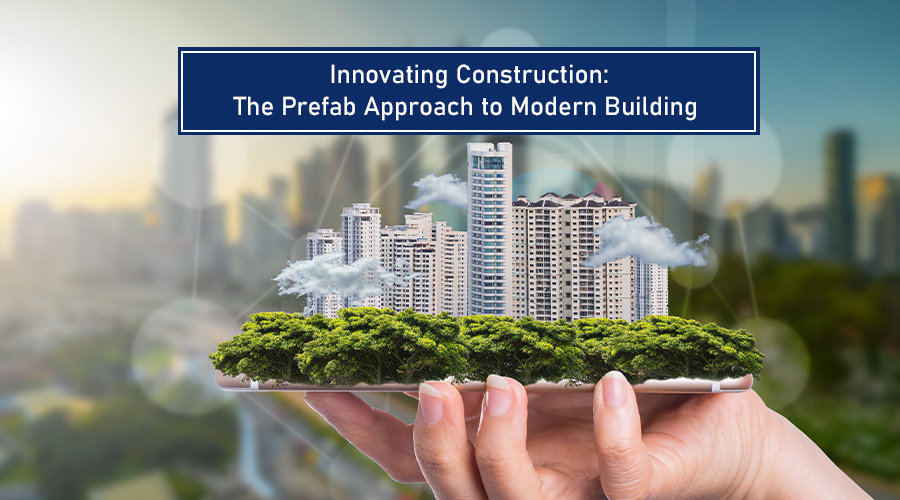For over a century, the image of construction has been synonymous with sprawling worksites, towering cranes, and the symphony of hammers and saws. But a quieter revolution is brewing, one that’s transforming the industry from the ground up: prefabricated construction.
Prefab, as it’s commonly called, isn’t entirely new. Think of those quaint, modular homes lining the coast. However, with advancements in technology and a growing need for efficient building solutions, prefabrication is experiencing a surge in popularity.
So, what exactly is prefab, and why is it changing the game?
Building Blocks of Change: Understanding Prefabrication
These components, ranging from wall panels to entire building sections (modules), are then transported to the construction site for assembly.
Imagine a Lego set for buildings. Each prefabricated element is meticulously designed and manufactured to seamlessly fit together, ensuring a quicker and more streamlined on-site assembly process.
The Allure of Prefab: Unveiling the Advantages
The rise of prefab isn’t just a fad; it’s driven by a compelling set of advantages that are revolutionizing the construction industry. Here are some of the key benefits:
- Speed Demon: Time is money, and prefab construction delivers on that promise. By shifting a significant portion of the work from the unpredictable elements of a construction site to a controlled factory setting, prefab projects can be completed up to 50% faster than traditional methods. This is a game-changer for projects with tight deadlines or those facing unfavorable weather conditions.
- Cost Cutter: Prefabrication isn’t just about speed; it’s about efficiency. The controlled factory environment allows for better resource management, minimizing material waste and optimizing labor costs. Additionally, the faster construction timeline translates to reduced time-related expenses like equipment rentals and site management.
- Quality Control Champion: Imagine a world where every building component is meticulously crafted and inspected before it even reaches the construction site. Prefabrication offers this very reality. Factory settings allow for stricter quality control measures, resulting in consistent, high-quality building components that contribute to a more durable and reliable final structure.
- Sustainability Superhero: The construction industry is a significant contributor to environmental impact. Prefabrication helps combat this by minimizing waste and maximizing resource efficiency. With less on-site construction activity, there’s less energy consumption and a reduced carbon footprint. Think of it as building greener, one prefab component at a time.
- A Touch of Humanity: Addressing Potential Concerns
While prefab offers a multitude of benefits, it’s important to acknowledge some potential concerns:
- Design Flexibility: There’s a misconception that prefab equates to cookie-cutter designs. While there’s a degree of standardization in the components, prefabrication allows for a surprising level of design flexibility. Architects and engineers can work with prefab manufacturers to create unique and innovative structures that cater to specific needs.
- Skilled Labor Shortage: The construction industry faces a skilled labor shortage. However, prefab can help mitigate this by shifting some of the work to a factory setting, where a different skill set might be required. Additionally, prefab construction can create new job opportunities in factory production and specialized assembly roles.
The Future of Building: A Prefabricated World?
Prefabrication isn’t a silver bullet, but it’s a powerful tool that’s transforming the way we build. As technology advances and the demand for faster, more efficient construction solutions grows, prefab is poised to play an even bigger role in shaping the future of the built environment.
Imagine a world where hospitals can be erected in record time to meet emergencies or schools can be quickly built in underserved communities. The possibilities are vast, and the potential impact on our society is significant.
The Human Touch in Prefabrication
While prefabrication leverages technology and automation, it doesn’t diminish the human element of construction. Skilled professionals are still required for design, engineering, factory production, and on-site assembly. Prefabrication simply allows these professionals to work smarter, not harder, by creating a more efficient and controlled building environment.
The rise of prefab is more than just a shift in construction methods; it’s a reflection of our evolving needs and expectations. We live in a fast-paced world, and prefab construction offers a way to build the structures we need, when we need them, while minimizing environmental impact. It’s a win-win for society, the environment, and the future of building.

